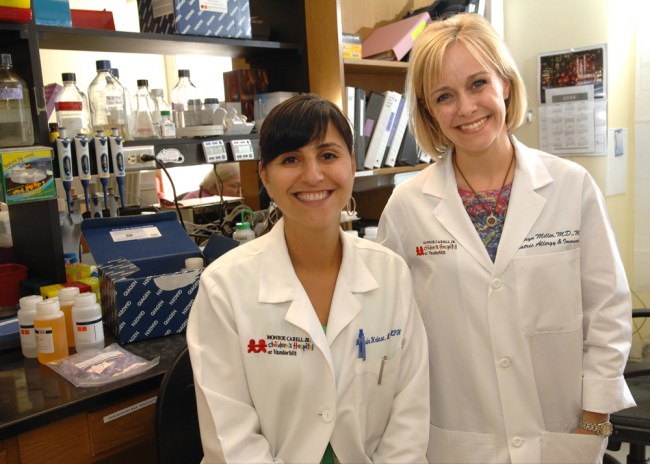
Natasha Halasa, M.D., M.P.H., left and Kathryn Miller, M.D., M.P.H., are studying rhinovirus C's impact on young children.
Investigators track viruses across globe
Investigators at the Monroe Carell Jr. Children's Hospital at Vanderbilt went overseas to complete research they say will further two concepts in the study of infectious diseases — that the common cold is a more important cause of serious illness in young children than previously thought, and that careful use of surveillance for infectious agents could benefit people around the globe.
Kathryn Miller, M.D., M.P.H., assistant professor of Pediatric Allergy and Immunology, is first author and Natasha Halasa, M.D., M.P.H., assistant professor of Pediatric Infectious Diseases, is principal investigator of a study published in the Journal of Clinical Virology entitled “Human Rhinovirus C associated with wheezing in hospitalized children in the Middle East.”
Najwa Khuri-Bulos, M.D., adjunct professor of Pediatric Infectious Disease at Vanderbilt and professor of Pediatrics and head of Infectious Diseases, Department of Pediatrics at Jordan University, worked with Halasa and Miller to complete the three-month viral surveillance project in Amman, Jordan.
The team enrolled children younger than 5 who were admitted with fever and/or respiratory symptoms from two hospitals in Jordan. Over a three-month period, 744 children were enrolled, and 37 percent were found to have rhinovirus.
“The first thing we noted was the surprisingly large number of enrollees,” Halasa said. “It’s a lot of children in small amount of time, demonstrating the high burden of respiratory illness in young hospitalized children. We expected to enroll only a couple hundred.”
Miller, who has published previously on the impact of rhinovirus on hospitalized children in the United States, said this is further proof that the rhinovirus can lead to nearly as many hospitalizations as respiratory syncytial virus (RSV) in younger children and infants.
“In particular, children who were infected with human rhinovirus C, which is a newly described rhinovirus, had a more pathogenic course of illness, with more wheezing and a greater need for oxygen,” Miller said.
Miller said this could lead to further study of rhinoviruses because as many as 15 percent of older children and adults documented to have the virus actually have no symptoms. The virus also has a long shedding period, about two weeks.
“In this study we also found it was common for infants and toddlers to have a co-infection, with both RSV and rhinovirus,” Miller said. “Those children tend to get even sicker than those who have either virus alone. The interesting thing about co-infection of RSV and Rhino is the majority of those patients were less than 2 months old.”
Halasa said this pilot study began when Khuri-Bulos was invited to visit Vanderbilt by Sten Vermund, M.D., Ph.D., director of the Vanderbilt Institute for Global Health. Khuri-Bulos was aware of how Vanderbilt’s New Vaccine Surveillance Network (NVSN) helped determine the burden of viral respiratory illness in the United States.
She was particularly interested in the use of polymerase chain reaction (PCR) testing to identify different viruses. PCR surveillance was used by the NVSN to prove the need for universal flu vaccine in children in the United States.
“While some studies looking at the cause of respiratory illness in Jordan were performed in the past, only one of these had utilized PCR. The sample sizes in these studies were small,” Khuri-Bulos said.
“Determining the cause of these infections is becoming increasingly important since respiratory infections are the leading cause of death among children. Better surveillance allows for use of vaccines available for prevention of influenza virus as well as other infections.”
Khuri-Bulos is planning a year-round surveillance project with Halasa. As a member of the National Preparedness plan for H1N1 in Jordan, Khuri-Bulos said plans are in place to immunize health care personnel as well as well as people at high risk for H1N1.
While Jordan has an excellent and free childhood immunization program, the burden of H1N1 disease in the general population is to be determined.
It is hoped that collaboration with Vanderbilt may convince Jordan and other countries to invest in better viral surveillance systems.
“The impact of better surveillance in countries like Jordan could have a global impact. There is a lot of tourism, military and business traffic in and out of Amman,” Halasa said.













